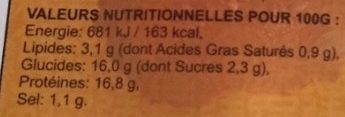XIU MAI Bouchons au porc - Sing'ly - 1 kg
This product page is not complete. You can help to complete it by editing it and adding more data from the photos we have, or by taking more photos using the app for Android or iPhone/iPad. Thank you!
×
Barcode: 3507981022061 (EAN / EAN-13)
Quantity: 1 kg
Packaging: Plastic, Fresh, Tray
Brands: Sing'ly
Categories: Meats and their products, Frozen foods, Meals, Pasta dishes, Meals with meat, Stuffed pastas, Pork meals, Ravioli, Frozen ready-made meals, Frozen ravioli, fr:Ravioli au porc, fr:Xiu Mai
Labels, certifications, awards: Made in France
Origin of ingredients: France
Manufacturing or processing places: France
Traceability code: FR 93.014.005 CE - Clichy-sous-Bois (Seine-Saint-Denis, France), EMB 93014D - Clichy-sous-Bois (Seine-Saint-Denis, France)
Countries where sold: France
Matching with your preferences
Environment
Packaging
Transportation
Report a problem
Data sources
Product added on by kiliweb
Last edit of product page on by packbot.
Product page also edited by beniben, moon-rabbit, openfoodfacts-contributors, sebleouf, yuka.UmJwZlBiNVloc0k0b3YwYjJFdnpxc3BMNjdhcVptSHBPN3RPSUE9PQ.










